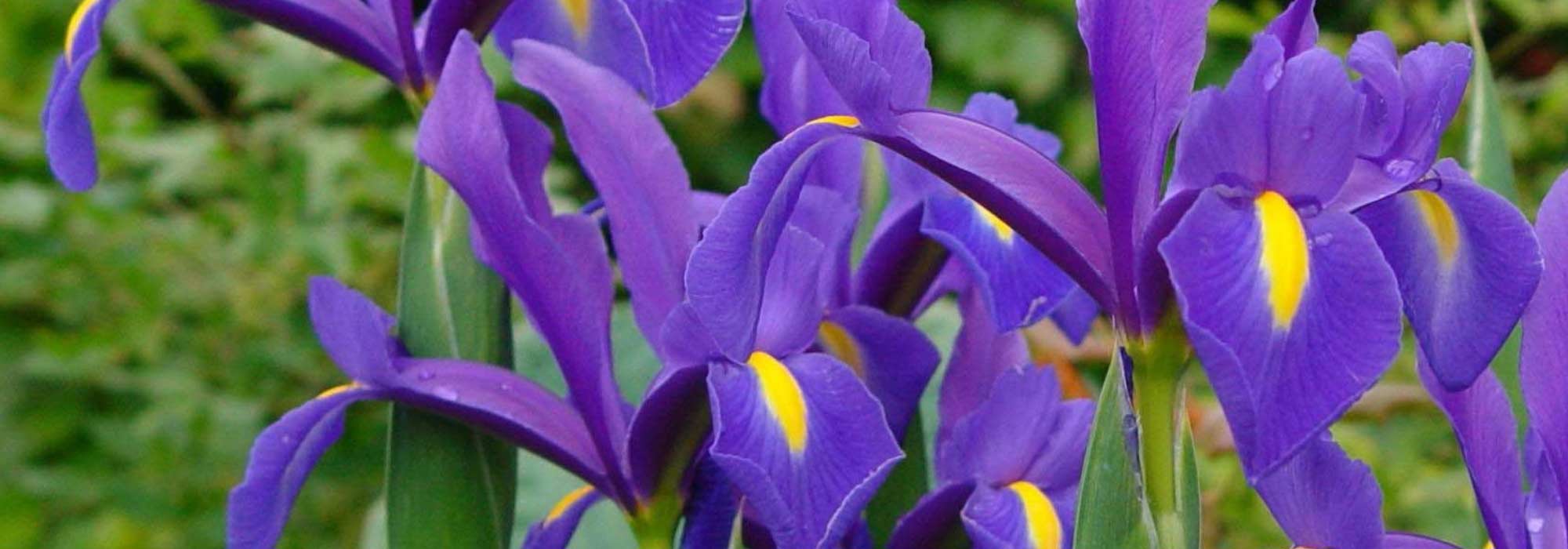
Dutch iris: planting and growing
Contents
Dutch Iris in a nutshell
- A perennial bulb that produces large, stylised flowers in vivid colours from April to June
- Essential plant for structuring a spring garden!
- It is easy to grow in light soil and naturalises in well-drained soil
- Hardy, it can remain in ground from one year to the next
- It is superb in borders, rockeries and slopes as well as in bouquets
A word from our expert
L’Dutch Iris is one of the most beautiful spring bulbs and very easy to grow. Essential in gardens and bouquets, it is grown for its graceful, pretty blue, purple, white or yellow flowers, perched atop slender stems.
The elegant, majestic flowering of Dutch Iris is truly its hallmark.
From the famous Dutch Iris ‘Blue Magic’ with its cobalt-blue flowers picked out with golden-yellow, to the white Dutch Iris or the Iris hollandica ‘Royal Yellow’, all stand out for their beautiful display in beds.
Undemanding, it is easy to grow in light soil and flowers reliably each year in beds, rockeries, banks or sunny borders.
When and how to plant these Dutch Iris bulbs with such stylised, cheerful flowers, and what tips will help you grow them successfully in the garden? You will love our Dutch Iris bulbs in mixed selections as well as single-colour versions!
Description and botany
Botanical data
- Latin name Iris hollandica
- Family Iridaceae
- Common name Dutch iris, bulbous iris
- Flowering April to June
- Height 0.40 to 0.80 m
- Exposure Sun, partial shade
- Soil type All, well-drained
- Hardiness -15°C to -20°C depending on varieties
The Dutch iris (Iris x hollandica) is a bulbous iris, belonging to large botanical family Iridaceae. This perennial originates from cross-breeding between different bulbous iris species of the xiphium group: Iris filifolia and Iris tingitana. It grows across a wide range of geographical zones in Northern Hemisphere.
Genus comprises more than 300 species, commonly divided between rhizomatous irises and bulbous irises. Among bulbous irises are famed Dutch iris and Iris reticulata, with which it is sometimes confused but which flowers earlier, is much smaller (does not exceed 15 cm in height) and is perfect for rockeries.
Unlike garden iris or Iris germanica, which form large rhizomes at soil surface, Dutch iris has an underground storage organ in the form of a bulb.
From a small round bulb emerges an upright, narrow clump that rises 40 to 70 cm in flower. Plant tends to bulk up over time by producing bulblets. Once established, these bulbs naturalise easily in drained soil where they rebloom reliably for many years, remaining floriferous for at least 4 to 5 years.
Each bulb produces a few long, narrow, linear leaves. Leaves are leathery, slightly channelled, medium green to glaucous. This tapered foliage, folded in two, resembles grass, especially when it curves gracefully towards ground. Leaves are deciduous and disappear completely in summer, marking a period of vegetative dormancy. They often appear from autumn and persist depending on winter severity.
Flowers appear borne at top of tall, graceful, very stiff, smooth stems sheathed by fine strap-like foliage. Bulbous iris is among earliest plants to flower in spring. Flowering occurs from April to July for 2 to 3 weeks, depending on variety, producing large, stylised, sculptural flowers. Their beauty is such that iris flowers are always much sought after.
Flowers, solitary or paired on stems, measure 7 to 10 cm in diameter and open successively. They are composed of six spatulate tepals: three small, erect inner petals overtop three broader outer sepals, almost horizontal or sometimes pendulous, maculate with a yellow‑orange spot, sometimes surrounded by a white halo. They are delicately dentate at margins and arranged alternately. Three stamens inserted at base of outer tepals.

Some Dutch irises: ‘Blue Magic’, ‘Bronze Queen’, ‘Apollo’ and ‘White Excelsior’
Dutch iris flowers are smaller than those of Iris germanica and unlike some rhizomatous irises, they do not have a beard, those small, downy, coloured tongues found on sepals of so-called bearded irises.
They display striking colours, often bicolour or tricolour, sometimes so intense they verge on baroque, ranging from <strong-purple‑violet to sky blue, from yellow to pure white and even . They are always brightened by a contrasting spot that enlivens colour at base of sepals. Cultivar ‘Eye of the Tiger’ stands out with unique bicolour bloom in bluish‑violet and purple.
With a translucent, velvety texture, delicately veined petals reveal fine vascular lines.
This exceptionally elegant flowering is unfortunately short-lived; once open, each flower lasts 5 to 7 days. Dutch iris also provides excellent cut flowers, striking in sophisticated bouquets alongside roses, arums or lilies.

Iris ‘Professor Blaauw’ and ‘Casablanca’ (variety similar to ‘White Excelsior’) – photo ibulbs
After flowering, flowers develop into fruits taking form of trigonous or hexagonal pods containing large seeds.
Hardy to -20°C, though perhaps slightly less so than other irises, Dutch iris is easy to grow in sun in light, well-drained soil without stagnant moisture. It tolerates ordinary but fertile, deep soil, even sandy or stony.
Dutch iris flowers are fabulous focal points in a contemporary or cottage border.
This strikingly graphic bulbous plant, with strong decorative potential, flowers in borders, rockeries, elegantly edges a path and very sunny slopes.
Main species and varieties
Iris hollandica declinates into cultivars with varied, vibrant and sometimes unusual colours, such as Iris ‘Blue Magic’ or ‘Golden Harvest’, with a sparkling golden-yellow.
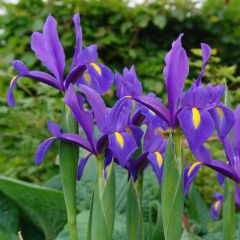
Iris hollandica Blue Magic - Dutch Iris
- Flowering time June, July
- Height at maturity 50 cm

Iris x hollandica Sapphire Beauty
- Flowering time June, July
- Height at maturity 55 cm
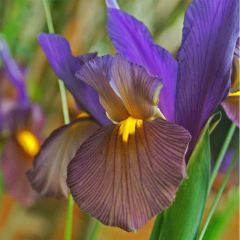
Iris hollandica Eye of the Tiger - Dutch Iris
- Flowering time June, July
- Height at maturity 50 cm
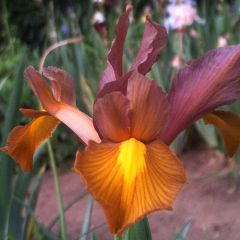
Iris x hollandica Bronze Queen
- Flowering time June, July
- Height at maturity 55 cm
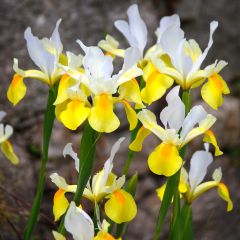
Iris x hollandica Apollo
- Flowering time June, July
- Height at maturity 50 cm
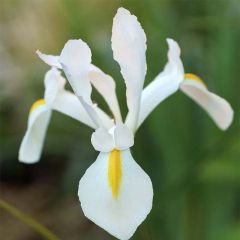
Iris x hollandica White Excelsior
- Flowering time June, July
- Height at maturity 55 cm

Iris hollandica Royal Yellow - Dutch Iris
- Flowering time June, July
- Height at maturity 60 cm
Discover other Iris hollandica - Dutch iris
View all →Available in 1 sizes
Available in 1 sizes
Available in 1 sizes
Available in 1 sizes
Available in 1 sizes
Available in 1 sizes
Available in 1 sizes
Available in 1 sizes
Available in 1 sizes
Planting
Where to plant Iris hollandica?
Very easy to grow, Iris hollandica proves very hardy, resisting severe frosts when growing conditions are optimal. Bulbs can overwinter in the ground even in cold regions. Once established, they will flower year after year. It is a fairly adaptable iris, more accommodating than some of its relatives.
It prefers full sun or partial shade, in a rich but light, well-drained soil, even sandy or rocky in which it will readily naturalise.
Well suited to hot, dry summers, it does, however, dislike heavy waterlogged soils that would rot its bulb.
Once well established in drained soil, Iris hollandica will remain in place for several years.
Planted in numbers, rather than singly, the spectacular inflorescences of Iris hollandica give substance to a bed with their highly architectural presence. Plant them in numbers in rockeries, to give structure to a sunny border or bed of perennials that will take over flowering during its summer dormancy.
After flowering, foliage yellows quickly, hence the advantage of pairing them with other flowering plants to hide it and avoid large gaps in beds in mid-summer.
The tallest varieties should be grouped at the back of a bed of perennials or flowering bushes.
When to plant Iris hollandica bulbs?
Planting Iris hollandica bulbs is done in September–October, to give them time to establish and to generally flower in late spring and early summer.
How to plant Iris hollandica bulbs
The Iris hollandica are planted in small groups of the same variety for a natural yet spectacular composition. Avoid mass planting because their flowering is short-lived and their foliage withers quickly.
Best effect is achieved with a dense planting of 30 to 50 bulbs per m². Plant at least 5 bulbs of the same variety. Height of Iris hollandica varies from about 30 to 80 cm, so bulbs come in different sizes ranging from size 5 to size 8+. They quickly increase in size once well buried deep in the ground! Like most flower bulbs, they require a light, well-drained soil.
- If your soil is heavy, lay a bed of sand or gravel directly under the bulbs
- Lighten soil if necessary with some coarse sand or compost
- Plant bulbs 10 cm deep (about twice their height), spaced 10–15 cm apart
- Water once a week
- Keep dry in summer
→ Learn more in our tutorial: How to plant Iris hollandica bulbs?
Read also
How to protect bulbs from rodents?Pruning and care
Undemanding, Dutch Iris requires limited attention. Avoid overwatering.
During growth, water once a week. In summer, keep bulbs almost dry during their summer dormant period.
Remove faded flowers by cutting them off at the base as they fade to prevent plant from exhausting itself by setting seed.
You can apply a potassium-rich fertiliser in early spring and again after flowering; future flowering will be even better.
After flowering, you may be tempted to cut back withered leaves: only cut foliage when completely dry, while still green leaves allow bulb to replenish reserves needed for next flowering.
To rejuvenate ageing clumps, lift or divide bulbs in autumn when they seem less floriferous, often after 4 to 5 years.
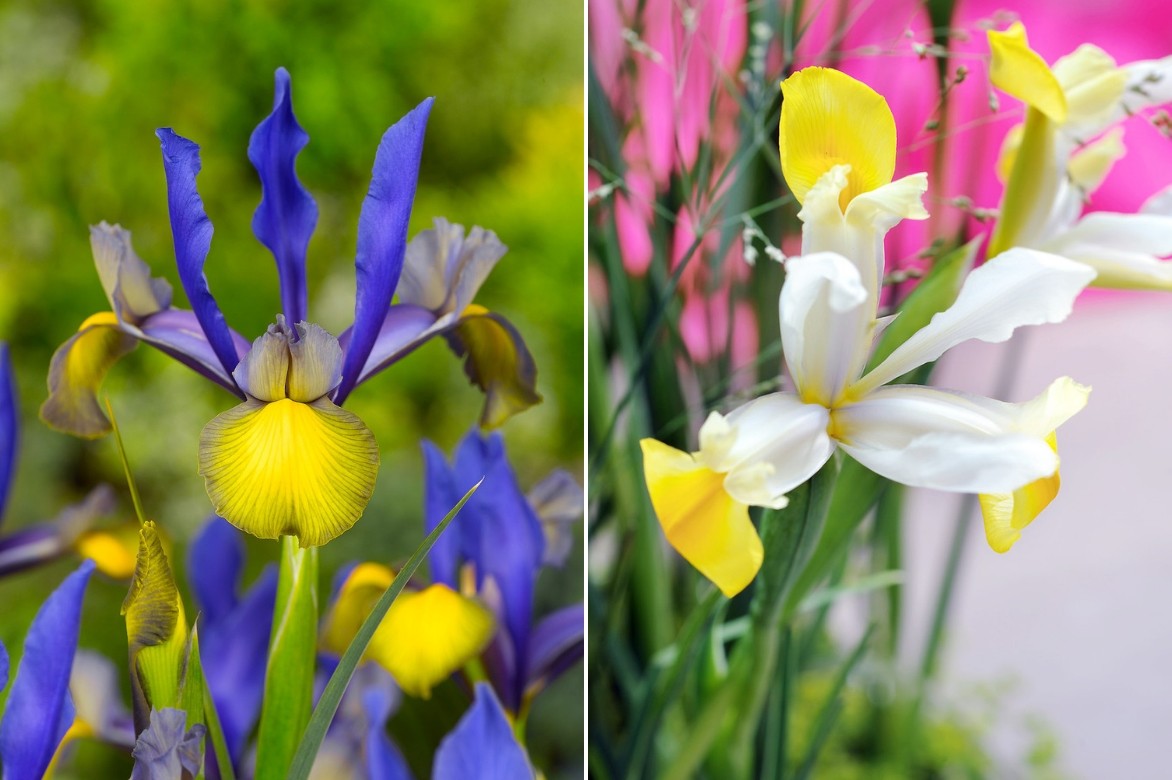
Iris ‘Miss Saigon’ / Iris ‘Apollo’ – photos ibulbs
Potential diseases and pests
Dutch iris is a bulbous plant fairly resistant to diseases and pests. Like most flowering bulbs, it dislikes permanently wet soil. In poorly drained soil, bulbs can sometimes be affected by white rot: remove stained and diseased bulbs.
Slugs and snails can attack bulbs in spring: discover our tips to keep them away.
Propagation
Dutch Iris is propagated by separating bulblets. Carry out division after flowering on clumps at least three to four years old and only when flowering has completely finished. Division also helps rejuvenate plants.
- Use a digging fork to lift the clump
- Gently separate bulblets from the mother bulb
- Replant immediately into well-prepared, free-draining soil
Associating
With its large stylised flowers, the Dutch Iris is indispensable in a naturalistic garden, a cottage garden or, as in a contemporary border to create elegant, colourful scenes, spectacular yet fugacious. It is one of mixed-borders’ great classics, to which it lends height, elegance and character. It is perfect for forming bold splashes of colour in beds.
Dutch Iris flowers are indispensable in a blue garden. It brings contrast to blue‑purple/yellow combinations or provides a harmonious monochrome scheme in purple, blue or white.

An idea for a combination: Alchemilla mollis, Carex testacea ‘Prairie Fire’ (green in spring, copper in autumn!), Lithodora diffusa ‘Heavenly Blue’, Euphorbia cyparissias ‘Orange Man’ and Iris hollandica ‘Professor Blaauw’
This handsome bulbous plant pairs easily with perennials from which it emerges majestically. Once flowering has finished, foliage dies back rapidly, so it is best combined with other flowering plants such as valerians, euphorbias, California poppies, daylilies, Iris germanica and delphiniums, as it goes into dormancy in mid‑summer.
Mix it with other bulbous plants such as ornamental alliums or Iris reticula, lilies or even late tulips.
Dutch Iris take over from spring bulbs such as tulips or daffodils and from early perennials such as hellebores.
Plant it in medium of bed at foot of flowering bushes such as brooms, forsythias and lilacs, whose spring flowering it will beautifully complement. It also looks superb planted among peonies or bush roses, which will mask its absence after flowering.
Useful resources
- Discover all our tips for planting and pairing your spring bulbs!
- We have the most beautiful collection of irises: treat yourself!
- Discover how to pair Dutch irises.
- Iris are perfect for lining a path — which plants to pair them with?
- Incorporate Dutch irises into a splendid colourful mixed border
- Go and discover the Parc Floral de La Source in Orléans, France; it is part of the floral circuit, the Route of Irises
- Iris: our 2023 new varieties
- Subscribe!
- Contents
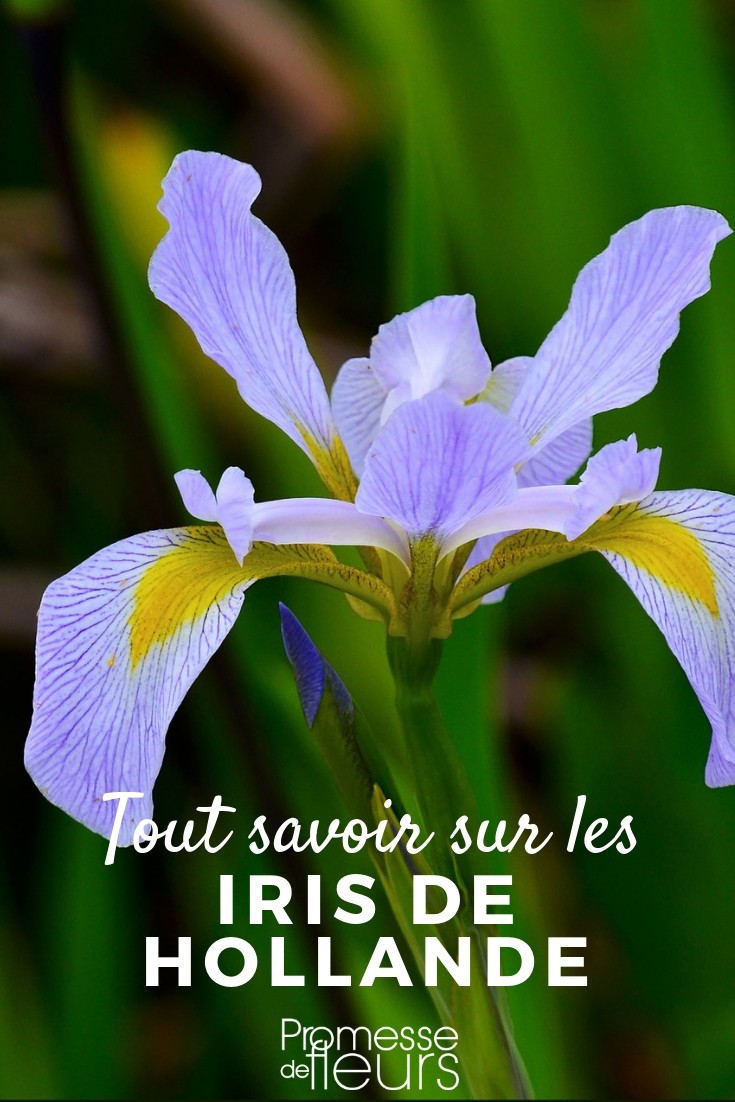



































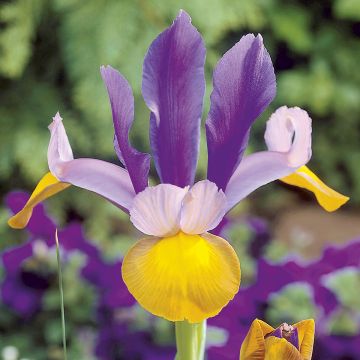
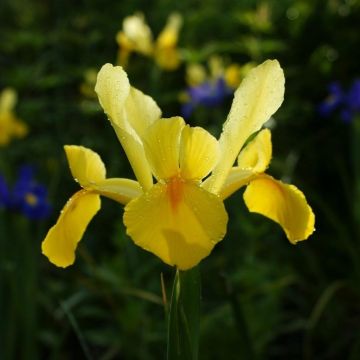
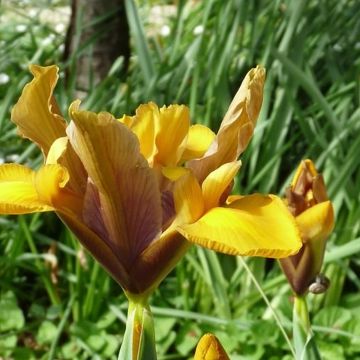
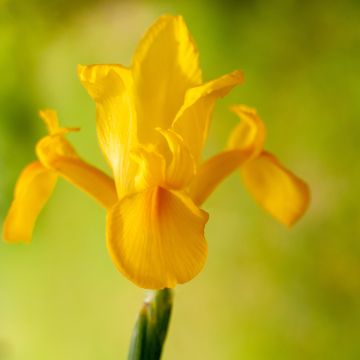

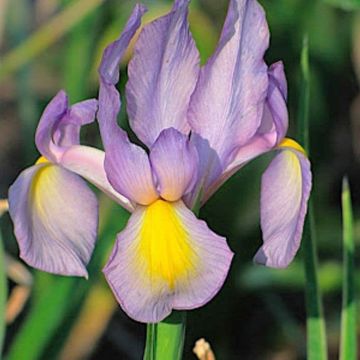
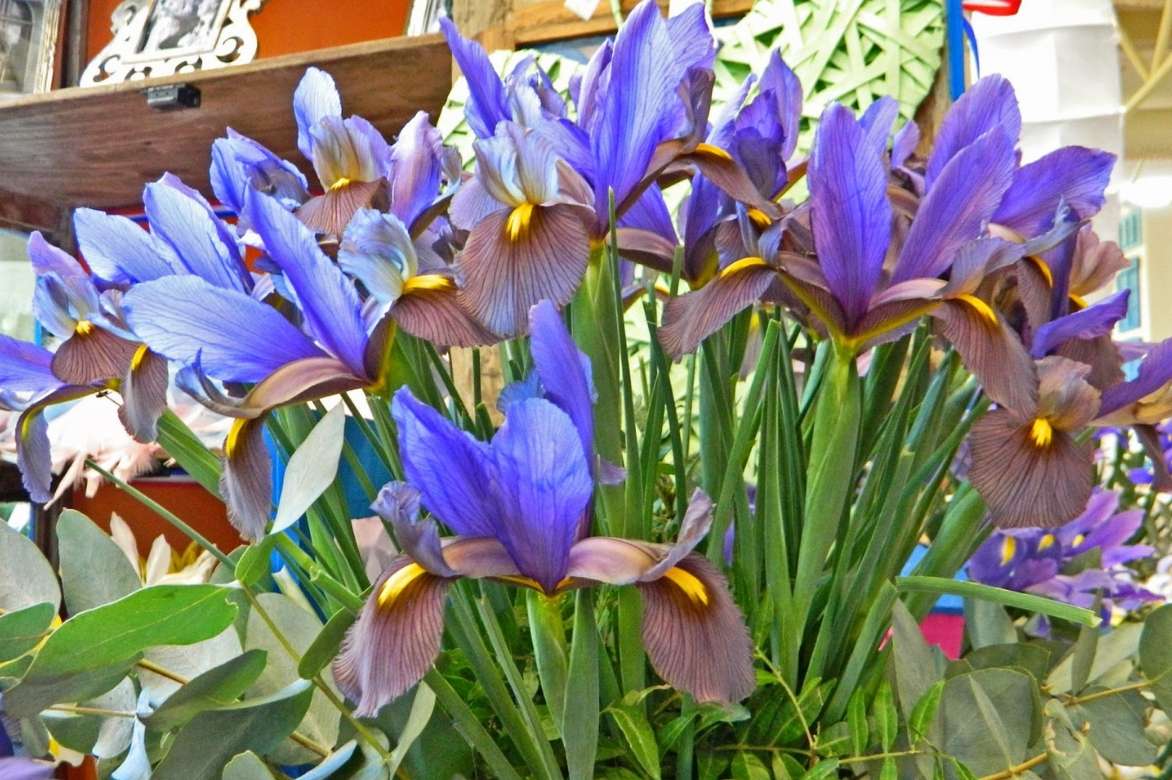
Comments